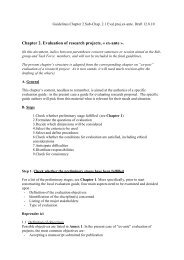- Page 1 and 2:
ACADÉMIE ROYALE DES SCIENCES DOUTR
- Page 3 and 4:
CLASSE DES SCIENCES MORALES ET POLI
- Page 5 and 6:
Zitting van 15 mei 1973 De zitting
- Page 7 and 8:
— 419 — 2. De nieuwe statuten v
- Page 9 and 10:
— 421 — Deze uiteenzetting word
- Page 11 and 12:
— 423 — Geheim comité De ere-
- Page 13 and 14:
— 425 — 1 utilisation de l’al
- Page 15 and 16:
— 427 — soient d’ordre biogra
- Page 17 and 18:
— 429 — constate en tout premie
- Page 19 and 20:
— 431 — dans la correspondance
- Page 21 and 22:
— 433 — station au départ d’
- Page 23 and 24:
- - 435 — tions intéressantes qu
- Page 25 and 26:
— 437 — ANNEXES 1. C o r r e s
- Page 27 and 28:
— 439 — être I décidé et je
- Page 29 and 30:
— 441 — 13-X-1902: LAURENT M.D.
- Page 31 and 32:
Jean Puissant. — Quelques témoig
- Page 33 and 34:
— 445 — ge forcent de nombreux
- Page 35 and 36:
— 447 — ligne directe postale e
- Page 37 and 38:
— 449 — antipodes de la Belgiqu
- Page 39 and 40:
— 451 — aller de notre logement
- Page 41 and 42:
— 453 — on ne trouve presque pl
- Page 43 and 44:
5. Une lettre d’émigré — 455
- Page 45 and 46:
— 457 — J’ai été frappé d
- Page 47 and 48:
— 459 — d’autres compagnons c
- Page 49 and 50:
— 461 — (2) D h o n d t , J.:
- Page 51 and 52:
— 463 — (23) Annexe 1. « Le Pe
- Page 53 and 54:
— 465 — Sa m e n v a t t in g D
- Page 55 and 56:
— 467 — ontwikkelingseffect fel
- Page 57 and 58:
— 469 — dienste hebben een toev
- Page 59 and 60:
— 471 — in sommige N.G.O.-kring
- Page 61 and 62:
— 473 — haar eigen kristelijke
- Page 63 and 64:
J.-P. Harroy. — Présentation du
- Page 65 and 66:
Séance du 19 juin 1973 Zitting van
- Page 67 and 68:
Zitting van 19 juni 1973 De zitting
- Page 69 and 70:
— 481 — « L’organisation de
- Page 71 and 72:
— 483 — belgo-congolaise à la
- Page 73 and 74:
— 485 — les couches plus ancien
- Page 75 and 76:
— 487 —- Il est possible qu’e
- Page 77 and 78:
— 490 — 7 F ra L uca d a C alta
- Page 79 and 80:
— 492 — 9 Toussaint (Auguste):
- Page 81 and 82:
— 494 — 11 Sacrae Congre gation
- Page 83 and 84:
— 496 — 13 N a id u (S .B .): L
- Page 85 and 86:
— 498 — 15 Baldwin (Robert E.):
- Page 87 and 88:
— 500 — 17 Scheider (Marcel) (R
- Page 89 and 90:
Séance du 22 mai 1973 M. R. Vanbre
- Page 91 and 92:
— 504 — La Classe décide la pu
- Page 93 and 94:
— 506 — La Classe désigne resp
- Page 95 and 96:
P.C.C. Garnham. — History of the
- Page 97 and 98:
— 510 — unlikely to penetrate d
- Page 99 and 100:
— 512 — the exoerythrocytic sch
- Page 101 and 102:
— 514 — fed, but only three bec
- Page 103 and 104:
— 516 — colleagues in order to
- Page 105 and 106:
— 518 — accept criteria based o
- Page 107 and 108:
Fig. 4 Liver of monkey: nearly matu
- Page 109 and 110:
J.-B. Jadin *, E. Willaert * et J.
- Page 111 and 112:
— 522 — Naegleria, trois souche
- Page 113 and 114:
D iscussion — 524 — N o u s v o
- Page 115 and 116:
— 526 — L e s a g e , A . : Cul
- Page 117 and 118:
Séance du 26 juin 1973 M. F. Jurio
- Page 119 and 120:
— 530 — Contribution britanniqu
- Page 121 and 122:
— 532 [.cs rapporteurs ont propos
- Page 123 and 124:
M. Van Himme *. — Le problème du
- Page 125 and 126:
— 536 — s’entassent contre le
- Page 127 and 128:
— 538 — les Chobe Swamps au Bot
- Page 129 and 130:
— 540 — indigène en Australie,
- Page 131 and 132:
— 542 — vert foncé, sont petit
- Page 133 and 134: — 544 — rus et une autre de Com
- Page 135 and 136: — 546 — L’éradication manuel
- Page 137 and 138: — 548 — à 200 1/ha, mais à ca
- Page 139 and 140: — 550 — d’utiliser ces ennemi
- Page 141 and 142: — 551 — C h o w , C .-Y ., T h
- Page 143 and 144: Marcel Walraet. — Un aspect scien
- Page 145 and 146: — 555 — Laboratoire Sir Alfred
- Page 147 and 148: — 557 — à la Grande-Bretagne u
- Page 149 and 150: — 559 — nie), où il fit son do
- Page 151 and 152: — 561 — diguer les épidémies
- Page 153 and 154: — 563 — M e l l a n b y , Kenne
- Page 155 and 156: KLASSE VOOR TECHNISCHE WETENSCHAPPE
- Page 157 and 158: — 567 — Jaarlijkse wedstrijd 19
- Page 159 and 160: — 569 — l’auteur de la note p
- Page 161 and 162: — 571 — de l’intérieur du pa
- Page 163 and 164: — 573 — Au départ, il faut dis
- Page 165 and 166: — 575 — rapport au niveau de la
- Page 167 and 168: — 577 — Dans le cas d’un litt
- Page 169 and 170: — 579 — précipitations arrosan
- Page 171 and 172: — 581 — mais derechef elles app
- Page 173 and 174: — 583 — Il est suggéré qu’u
- Page 175 and 176: — 585 — deling of the flow of n
- Page 177 and 178: — 587 — PoREH and El a t a ( 2
- Page 179 and 180: — 589 — characteristic scales a
- Page 181 and 182: — 591 — As an application of th
- Page 183: — 593 — flows recently infiltra
- Page 187 and 188: — 597 — Fig. 9. — Sketch of t
- Page 189 and 190: — 599 — tion points exist above
- Page 191 and 192: Séance du 29 juin 1973 Zitting van
- Page 193 and 194: Zitting van 29 juni 1973 De H. F. B
- Page 195 and 196: — 605 — Deze mededeling wordt g
- Page 197 and 198: — 607 — Administratieve mededel
- Page 199 and 200: — 609 — organismes plus spécia
- Page 201 and 202: — 611 — de projets d’assistan
- Page 203 and 204: — II — — : A la mémoire du p
- Page 205 and 206: — IV — G o sse, J.-P.: Révisio
- Page 207: ARSOM, rue Defacqz 1, B-1050 Bruxel











